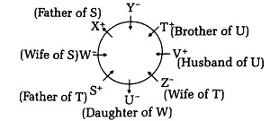Circular Arrangement Questions and Answer
Exercise
Linear/Row arrangement
Here, we deal with questions, where a proper arrangement is required to be done in a linear format along a straight line.
- When it is not given in the question that in which direction the person is facing, then we assume it facing the North direction.
- When A, B, C and D are facing in South direction and P, Q, R and S are facing in North direction in a line, then positions to their right and left will be

- When A, B are in one line and P, Q in other, then diagonnaly opposite directions will be

A is diagonally opposite directions to Q and B is diagonally opposite to P.
Circular Arrangement
In circular arrangement, persons/objects are arranged around a circle facing towards or outside the centre on the basis of information provided.
In the below arrangement, some persons are sitting around a circle and they are facing the centre. The diagram highlights the left and right of the people for this case.


- Movements around the circular arrangement:
- For the people facing the centre:
- Left movement is called clockwise rotation.
- Right movement is called anti-clockwise rotation.
- For people facing outside, the opposite is true:
- Left movement is called anti-clockwise rotation.
- Right movement is called clockwise rotation.
The information given in such questions specifies the position of a few or all the persons in the arrangement. The positions are specified through conditions like: a particular person is sitting right or left of the other person. After reading the given information, you should draw the diagram depicting the question statement.
Positions in the circular arrangement:
Following two shapes are of six and eight people sitting around a circle.


Remember, if you are careful of the directions, then this question should be a fairly easy one to solve.
Other geometrical shape arrangement:
In this type, questions are asked to arrange the persons in square, rectangle, pentagon, hexagon or any other geometrical shape.
1.Square/Rectangular Arrangement:
In this type of arrangement, objects/persons are placed around a rectangular or a square shaped table facing either at the centre or the direction opposite to centre. The left and right of each person in both the cases can be understood with the help of the following diagrams.


2.Pentagonal arrangement:
In this type of arrangement, objects/persons are placed around a pentagonal plane facing either at the centre or the direction opposite to centre. The left and right of each person in both the cases can be understood with the help of the following diagrams.


3. Hexagonal arrangement:
In this type of arrangement, objects/persons are placed around a hexagonal plane facing either at the centre or the direction opposite to centre. The left and right of each person in both the cases can be understood with the help of the following diagrams.

